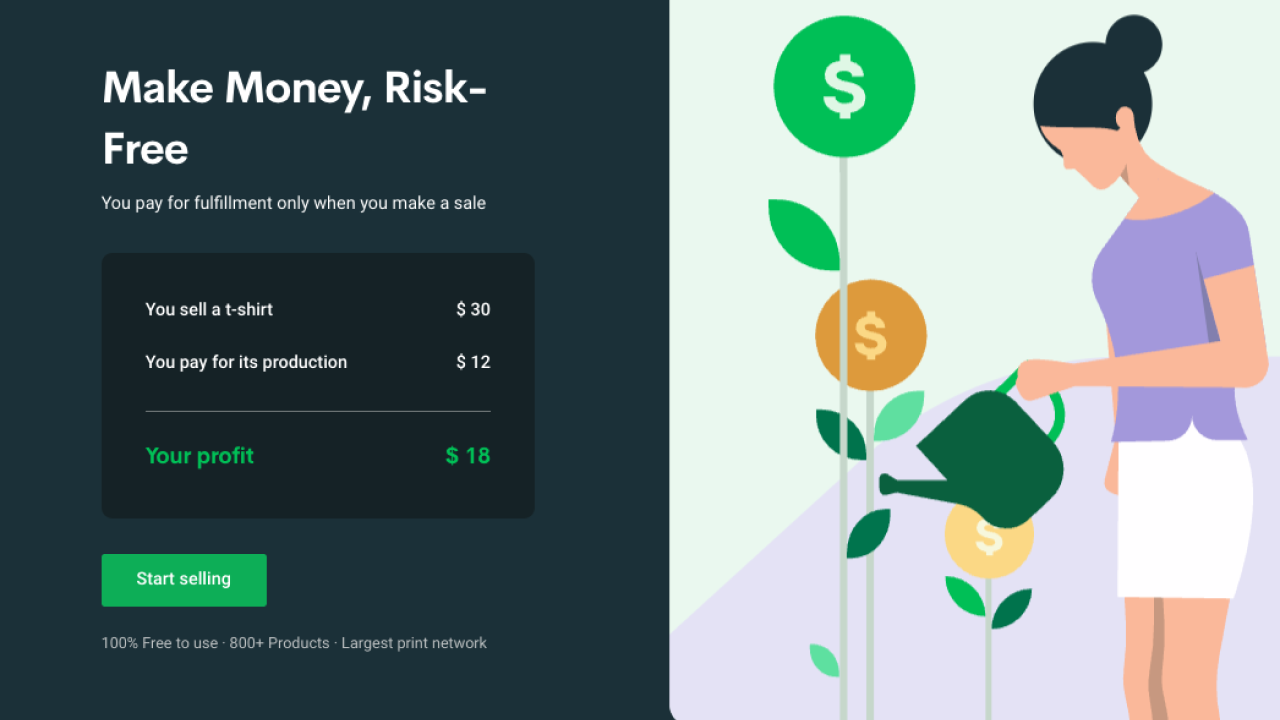Start a print-on-demand business today
Getting ready to start a dropshipping business? It’s a flexible, low-risk, low-cost way to get into eCommerce. It gives access to thousands of products in various categories, and you can sell them without ever handling or shipping the items yourself.
While all that sounds great, the question remains: how much does it cost to start dropshipping?
The costs of starting a dropshipping store can vary quite a bit and mainly depend on the steps you take.
As a dropshipping business owner, you need to consider the following:
- Business registration and license filing fees
- eCommerce platform and marketplace fees
- Domain and hosting costs
- Marketing expenses
- Product sourcing costs
- Taxes
- Supplier fees
- Shipping costs
With all the dropshipping tools and resources available online, you don’t need a lot of money to start a successful business. While in some cases, you can do with as little as a couple of dollars to start your store and build a following organically, around $50 to $100 can get you firing right out of the gate.
Keep reading to learn everything you need to know about your new business startup costs so you can build a store in no time.
Startup costs: General business expenses

As you take your first steps in eCommerce, some expenses occur regardless of whether you’re starting a dropshipping store or any other online business.
Let’s look at some of the most common startup costs.
Business registration and license filing fees
You may think: I just want to start a dropshipping side hustle, do I really have to register a business? While not always required, registration can give you and your business several benefits and protections.
Federal tax ID number
Get a federal tax ID number if you want to go the quick and free route. It’s your Employer Identification Number (EIN) that you’ll need to apply for business licenses and permits, open a bank account, hire employees, and pay federal taxes.
If you don’t have an EIN, apply for it for free with the IRS. You might also need to get a state tax ID number, depending on the state you operate in.
Business license

A business license can give you and your online store legal protection, build customer trust, help with tax compliance, and give you access to aid from the local government.
While there are several licenses you can get (e.g., Business Operating License, Seller’s Permit, Doing Business As (DBA) License or Permit, etc.), you need to pick one that fits your specific situation.
Business license fees can be between $50 and $400. Learn more about different licenses and how to apply in our article on How to Get a Business License.
Pro tip
Research all of the necessary licenses for conducting business in your state and country. All the information is publicly available, and you can get consultations from local authorities.
eCommerce platform and marketplace fees
Whether you decide to sell products on an eCommerce platform (e.g., Shopify, Wix, Squarespace) or an online marketplace (Etsy, eBay, Amazon, etc.), you’ll need to pay some fees.
eCommerce platforms
Creating a stand-alone store on an eCommerce platform gives you more customization options, but you must work harder to drive traffic.
Usually, eCommerce platforms require you to pay a monthly fee for using their services and a transaction fee for every sale you make.
For example, running a Shopify store with the Basic subscription plan costs $29 monthly with a 2.9% credit card fee + $0.30 per online transaction. The more you pay for a subscription, the lower these fees become.
Online marketplaces
While online marketplaces bring potential customers to the site and make it easy to start a store, customization options are limited.
Online marketplaces may require you to pay a fee for every product listing. You can also expect fees for each sales transaction.
For example, while signing up with Etsy is completely free, you must pay $0.20 for every product listing, a 6.5% transaction fee for each sale, and a payment processing fee of 3% + $0.25 for every item sold (it varies between countries).
Learn more
Not sure whether to go with an eCommerce platform or an online marketplace? Use our Sales Channel Overview to make a well-informed decision that suits your budget.
Domain and hosting costs
These costs apply to you if you plan on creating a stand-alone store.
A domain name is the unique identifier of your store. It gives your business credibility, helps search engines rank your store, and lets you control your online presence.
The domain price will depend on your keywords, the top-level domain (e.g., .com), and the domain registrar you use.
Here are some popular domain registrars and the prices they offer for registering and hosting a .com domain:
| Service provider | Domain registration cost | Web hosting cost |
|---|---|---|
| GoDaddy | $11.99 | Starting at $2.99/month |
| NameCheap | $9.58 | Starting at $1.29/month |
| Bluehost | $12.99 | Starting at $2.95/month |
| Hostinger | $9.99 | Starting at $1.99/month |
You can expect to pay between $10 and $50 per year for domain hosting. Make sure to check whether there are no steep price increases after the first year of your subscription.
Marketing costs

Before spending money on promotions, analyze your marketing budget and find the most profitable strategy for your eCommerce business. You can spend between a couple of bucks to a few hundred dollars on marketing activities.
Here are some popular marketing strategies for your eCommerce store:
Social media ads
Whether it’s TikTok, Instagram, or Facebook advertising, social media plays a massive role in attracting new customers to any online business.
The cost of social media ads will depend on the duration and objectives you set for the ad campaign. While there’s no specific amount of money you should spend on ads, Meta recommends starting with at least $5 a day over a span of six days.
Influencer marketing
The global influencer marketing value has grown from $6.5 billion in 2019 to $16.4 billion in 2022. Any successful dropshipper will tell you that influencers play a huge role in attracting new customers.
If you want to use this strategy, you’ll have to pay influencers for posts. For example, if we look at TikTok influencer pricing, one post can cost between $800 for nano influencers and more than $7,000 for mega influencers with over a million followers.
Email marketing
This strategy can offer a huge return on your investment. In fact, for every $1 you spend on email marketing, you can expect an average return of $40.
Check popular email marketing tools like HubSpot, Mailchimp, and ActiveCampaign. Free plans are usually limited in features. You can expect to pay $10 to $50 per month, depending on your needs and email list size.
Pro tip
Do you want to decrease your ad spend and promote your store for less money? Use search engine optimization to generate organic traffic for free:
– Optimize your store’s structure
– Include relevant keywords in product listings
– Create helpful and engaging blog content
– Write effective product descriptions
– Optimize your page titles and meta descriptions
Product sourcing costs
To build a successful dropshipping business, you need the right products. With so many dropshipping suppliers offering their services online, you must carefully analyze all available sourcing methods.
Here are some of the most popular product sourcing methods:
Wholesale and dropshipping platforms
Popular wholesale and dropshipping platforms include AliExpress, SaleHoo, and Wholesale2B. Each platform offers unique products and ships items from different locations worldwide.
Product costs depend on what you want to sell. To get product ideas for your store, check out our article on 15 Dropshipping Niches to Try and 5 to Avoid.
Private label products
Private label products are manufactured by third-party suppliers and sold under your brand. This option includes finding a manufacturer for your preferred goods (e.g., cosmetics) and adding your custom logo and packaging.
For example, Onoxa has various skincare items that cost below $5, but you must order at least 12 pieces. The more you order, the less it costs.
Print on Demand

This sourcing method lets you offer custom products with your unique designs, such as apparel, accessories, or home decor. Once you sell something in your store, a POD supplier like Printify prints the item and sends it directly to your customer.
This method is perfect for dropshipping because there are no minimum orders or upfront costs. All products are made on demand.
Product prices vary depending on the items you select, the materials used in their production, and the printing method applied.
Browse Printify’s Product Catalog to get a better idea of pricing.
Taxes
If you’re planning to run a dropshipping business, taxes are unavoidable. They differ from country to country, so you’ll have to acquire all the relevant information to make sure your business is tax compliant.
Here are some of the most common taxes you must consider:
- Sales tax. If you’re selling in the US, you’ll have to collect and remit sales tax for orders shipped to buyers in states where you have a nexus (a physical presence or economic connection). The sales tax rates vary from state to state and even from city to city.
If you select Printify as your supplier
While Printify is obligated to collect and remit sales tax on US orders being shipped within the country, you won’t need to pay sales tax for your customers’ orders if you can submit a valid resale certificate with your sales tax ID.
- Value-added tax. VAT applies to global sales – it’s a transactional tax charged on the sale of goods and services in over 115 countries worldwide. It usually falls between 5-27% of an order’s total cost.
- Income tax. You must pay income tax on your dropshipping profits. When calculating your income tax, you can subtract the cost of goods, shipping expenses, advertisement and marketing costs, and other business expenses.
Pro tip
Consult a tax specialist or a Certified Public Accountant for professional advice on taxes and regulations in your state and country.
Make it happen today!
Dropshipping fees and shipping costs

Unlike the general costs described above, these expenses depend on the supplier you select when starting a dropshipping business. They entail all costs associated with shipping and any additional fees your supplier might have.
Supplier fees
In addition to the product costs, most dropshipping suppliers have additional fees for their services, and they can vary a lot.
Here are some of the features that can build up your total dropshipping costs:
- eCommerce integrations
- Increased product limits
- Order synchronization
- Premium products
Let’s compare the costs of three popular dropshipping suppliers:
With over 8,000 carefully vetted suppliers and more than 2.5 million products on offer, the Basic subscription costs $27/month for 1-2 people, and the Premium subscription costs $97/month for teams.
With most suppliers based in the US and offering over a million products, signing up with Wholesale2B is free. But that doesn’t give you dropshipping order services. There are 17 different subscription plans for every major online sales channel – the prices range from $37.99 to $49.99 per month.
This platform offers over 16 million certified wholesale products. Most dropshippers are based in the US. Unlike other platforms with monthly fees, Worldwide Brands offers lifetime access for $299.
Learn more
Find the most suitable supplier for your business model and target audience in The 15 Best Dropshipping Suppliers for Your eCommerce Business.
Shipping costs
Since you won’t be running an actual retail store, you’ll have to pay the shipping for every product you sell.
The shipping cost of each item will vary depending on factors such as:
- Product size and weight
- Origin and delivery destination
- Delivery time (e.g., express vs standard shipping)
- The shipping provider you’ve picked
Here are some shipping options to look into:
- ePacket. This is a fast and affordable option for low-cost, lightweight packages sent from China to other countries. The standard delivery time from China to the US is 7 to 30 days and costs between $7 and $27.
- AliExpress Standard Shipping. This is a great option if you’re sourcing your products from AliExpress with product delivery from China. AliExpress Standard Shipping takes 15 to 45 days for order delivery, generally costing less than $5.
- Courier services. You can also use popular courier services like FedEx, DHL, and UPS. They cost more than the two previous options but offer much shorter delivery times.
- USPS. The United States Postal Service is a good option if you’re shipping within the US. They offer several shipping services at various prices.
- Local carriers. You can also look into local delivery companies operating in the countries you ship to. There are plenty of affordable and reliable options.
Pro tip
To keep the shipping costs as low as possible and avoid any potential customs fees for your buyers, look for suppliers closer to your target market.
How much does it cost to start a dropshipping business with Printify?
Printify is the best option for starting a dropshipping business. It’s free to use, offers over 850 customizable products, and integrates with all major eCommerce channels.
Why use Printify for your dropshipping business?
- 1,000+ customizable products. The Printify Catalog offers a variety of products in categories such as clothing, accessories, home decor, etc.
- Integrations with all major sales channels. Sell on eCommerce platforms such as Shopify, WooCommerce, Wix, or Squarespace, or use an online marketplace like Etsy or eBay.
- 80+ Print Providers worldwide. You can choose who’ll make your custom products. Pick a Print Provider based on their selection, pricing, location, shipping costs, and performance score.
- Free-to-use design tool. Creating custom products is a breeze with Printify’s user-friendly Product Creator (formerly known as Mockup Generator). Apply free designs, add text and images, or use the Shutterstock graphic library.
Cost of registration

Printify: Free to sign up.
Printify is free, but you can also access the Printify Premium plan for $29 monthly to get up to 20% off on all products.
Other dropshipping suppliers: Some offer free registration and free trials, but on most platforms, you have to spend money to access the product catalogs.
Product pricing

Printify: Competitive pricing, with prices varying between items and product categories. Bulk pricing is available for large orders.
For example, the cheapest t-shirt in the Printify Catalog costs under $7, while the most expensive ones (with all-over prints) cost $20 to $25.
Other dropshipping suppliers: Depends on the niche you’re catering to and the product category. For example, AliExpress has plenty of products under $10 that will give you some nice profit margins, and bulk pricing can lower your total expenses.
Shipping expenses
Printify: Depends on the Print Provider you select and their location.
For example, the best-selling Bella+Canvas 3001 t-shirt, printed by Monster Digital, costs $4.75 to ship within the US and $10 for the rest of the world. Every additional item costs less to ship.
Pro tip
Use Printify’s Order Routing Feature to reroute your orders to the Print Provider nearest your customer’s location. This will reduce shipping expenses and avoid customs fees.
Other dropshipping suppliers: Depends on their location. If you plan to sell within the US, using a dropshipping company based in the US will be cheaper.
Sales channel integrations
Printify: Connects to all major sales channels entirely for free. Use Shopify, WooCommerce, Wix, Etsy, eBay, and many other options.
Other dropshipping suppliers: Many dropshipping platforms don’t offer integrations and automation tools for your online store, while others ask you to pay a monthly fee for the service.
To sum up, you can start dropshipping with Printify with an extremely small investment. Everything’s free to use on the Printify side – all your costs will accrue from the eCommerce site you decide to use.
How much can I earn with Printify?
When setting the price of your products, you need to consider all of your items’ production and shipping costs, as well as the selling fees that apply to your store. Also take into account the prices offered by your competitors and the added value of your product.
Suppose you’re dropshipping Printify hoodies from SwiftPOD with a Shopify store.
| Product costs | $ |
|---|---|
| Production price (size M, color Sport Grey) | $23.61 |
| Shipping (US) | $8.49 |
| Shopify transaction fee | $0.30 |
| Total cost | $32.40 |
After doing some research, you see that your top-performing competitors offer similar hoodies for around $45.00, so you decide to set your price to $44.99. This leaves you with a profit margin of just under 40%.
Remember that Shopify charges a 2.9% credit card fee, adding up to $1.30 for your hoodie.
This leaves you with: $44.99 – $32.40 – $1.30 = $11.29.
What about covering my expenses?
We know how much you can earn from selling one hoodie, but how many would you need to sell to cover all your business-related expenses?
Let’s calculate your potential monthly expenses when dropshipping on Shopify:
| Expenses | $ |
|---|---|
| Shopify Basic | $29.00 |
| Personal domain | $2.00 |
| Design costs | $10.00 |
| Marketing | $40.00 |
| Total | $81.00 |
You need to sell seven or eight hoodies a month to cover all of your dropshipping expenses.
Learn more
Watch Printify’s Guide to Pricing Success to learn the ins and outs of product pricing and the costs associated with Print on Demand.
FAQ
To start your online store with Shopify, you need to pay $29.00 for the Basic subscription plan and around $15.00 for a custom domain (optional).
If you choose Printify as your dropshipping service provider, no upfront fees apply. But you need to set aside money for the production and shipping of your custom product when a customer pays for it in your online store.
Other expenses (e.g., design and marketing) and dropshipping startup costs are up to you.
All in all, you can easily start dropshipping on Shopify for less than $100.
Yes, the dropshipping business model is very profitable.
The global dropshipping market size is expected to grow from $128.6 billion in 2020 to a whopping $476.1 billion in 2026. Now’s the perfect time to start your dropshipping journey.
While it’s impossible to start dropshipping without any money, the upfront costs can be small.
All you need to start is to open an online store and find a suitable dropshipping supplier. For example, you only need a few dollars to create custom products with Printify and list them on Etsy.
You can organically generate sales and traffic to your eCommerce website without spending a dime.
Ready to reach your financial goals with dropshipping?
Do proper research, find the most suitable product source and sales channel, and get selling.












